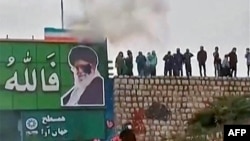Welcome back to The Farda Briefing, an RFE/RL newsletter that tracks the key issues in Iran and explains why they matter. To subscribe, click here.
I'm RFE/RL correspondent Golnaz Esfandiari. Here's what I’ve been following during the past week and what I’m watching for in the days ahead.
The Big Issue
Authorities in Tehran have accused Iran's foreign enemies of stoking unrest in the country with the goal of inciting a civil war.
Officials made the accusations following what they called “terrorist” attacks that took place on November 16 in Izeh, in the southwestern province of Khuzestan, and in the central city of Isfahan, where they said gunmen on motorbikes opened fire on security forces and civilians, killing seven in Izeh and two in Isfahan.
The incidents followed an October 26 attack at the Shah Cheragh shrine in Shiraz that left 13 dead. The Shiraz attack was claimed by the extremist group Islamic State (IS).
Speaking on November 18, Mohsen Rezai, Iran's vice president for economic affairs, blamed Tehran's enemies for the “bitter” incidents and claimed that they’re trying to create a civil war in the country. "Iran cannot be turned into another Syria or Lebanon by carrying out violent acts similar to the ones in Shah Cheragh, Isfahan, and Izeh," he said.
A day earlier, Iran's Foreign Minister Hossein Amir-Abollahian accused Israel and Western countries of plotting a "civil war" and the “disintegration” of the Islamic republic.
“Security services, [Israel], and Western politicians who have made plans for a civil war and the destruction and disintegration of Iran must know that that Iran is not Libya or Sudan,” Amir-Abdollahian said on Twitter, while failing to provide any evidence to back his claim.
Why It Matters: The warnings come amid nine weeks of antiestablishment protests in Iran triggered by the death of Mahsa Amini following her arrest by the morality police in Tehran. Iran has blamed foreign countries and intelligence services of orchestrating the unrest, which has turned into the most significant challenge to the clerical establishment in the past four decades.
Ali Alfoneh, an Iran analyst at the Arab Gulf States Institute in Washington, told RFE/RL that the Islamic republic has only itself to blame for the situation it faces, “but lacking the courage to look into the mirror and admit their own mistakes, regime officials cowardly blame the foreign powers.”
Others said Tehran could use the attacks as an excuse for a harsher crackdown on the protests. “We don't have a good sense of what happened in Izeh and Isfahan -- was it a terrorist group, or potentially the regime itself?" said Henry Rome, an Iran expert at the Washington Institute. "Either way, the government will probably use the attacks to send the message that the protests are undermining national security and opening the door for Western-backed terrorism," Rome added.
What’s Next: Statements by Iranian officials who have vowed a crushing response to those behind the "terrorist" attacks could provide clues about the country’s next steps. Authorities have said that the perpetrators of the attacks and their leaders who are allegedly based outside the country would be "introduced to the people."
Stories You Might Have Missed
• Activists say Iran has intensified its crackdown in the Kurdistan region in an attempt to spread fear among protesters and quell the nationwide antiestablishment protests that have rocked the country for the past two months.
• At least 47 children have been killed amid Iran’s ongoing crackdown on the protests that were sparked by the death in custody of Mahsa Amini. Among them is 9-year-old Kian Pirfalak who was killed on November 16 in the southwestern city of Izeh amid the antiestablishment protests. State media claimed that the boy was killed in a "terrorist attack." But his mother says he was shot dead by Iranian security forces. His tragic death led to an outpouring of grief and anger.
• Protesters in Iran set fire to the ancestral home of the Islamic republic's late founder, Ayatollah Ruhollah Khomeini, in the central Iranian city of Khomein, according to amateur videos posted online. Images of Khomeini have also been torched in past weeks amid the ongoing unrest.
What We're Watching
Iran said on November 22 that it had begun producing uranium enriched to 60 percent at its Fordo underground facility. The announcement was part of Iran's response to the UN nuclear watchdog's adoption last week of a resolution accusing Tehran of noncooperation. Tehran condemned the resolution as politically motivated while vowing retaliation.
"We had said that Iran would seriously react to any resolution and political pressure...that is why Iran has started enriching uranium to 60 percent purity as of Monday [November 21] at the Fordo site," the head of Iran's Atomic Energy Organization, Mohammad Eslami, was quoted as saying by state media.
Why It Matters: Enrichment at 60 percent is one step away from the 90 percent level required for nuclear weapons. Iran had already been enriching to 60 percent purity at other facilities.
The 2015 nuclear deal -- which has been on life support following the U.S. withdrawal from the international agreement in May 2018 -- had limited Iran’s nuclear enrichment activities to 3.7 percent for civilian purposes.
Tehran’s latest escalation is likely to lead to more concerns about the country’s nuclear activities from other countries that were party to the stalled nuclear deal and are working to revive it. The EU trio of Britain, France and Germany said in a joint statement that Iran’s increased enrichment “carries significant proliferation-related risks [and] has no credible civilian justification.”
That's all from me for now. Don't forget to send me any questions, comments, or tips that you have.
Until next time,
Golnaz Esfandiari
If you enjoyed this briefing and don't want to miss the next edition, subscribe here. It will be sent to your inbox every Wednesday.






